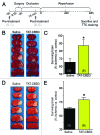Disruption of NMDAR-CRMP-2 signaling protects against focal cerebral ischemic damage in the rat middle cerebral artery occlusion model
- PMID: 22373559
- PMCID: PMC3367672
- DOI: 10.4161/chan.18919
Disruption of NMDAR-CRMP-2 signaling protects against focal cerebral ischemic damage in the rat middle cerebral artery occlusion model
Abstract
Collapsin response mediator protein 2 (CRMP-2), traditionally viewed as an axon/dendrite specification and axonal growth protein, has emerged as nidus in regulation of both pre- and post-synaptic Ca ( 2+) channels. Building on our discovery of the interaction and regulation of Ca ( 2+) channels by CRMP-2, we recently identified a short sequence in CRMP-2 which, when appended to the transduction domain of HIV TAT protein, suppressed acute, inflammatory and neuropathic pain in vivo by functionally uncoupling CRMP-2 from the Ca ( 2+) channel. Remarkably, we also found that this region attenuated Ca ( 2+) influx via N-methylD-Aspartate receptors (NMDARs) and reduced neuronal death in a moderate controlled cortical impact model of traumatic brain injury (TBI). Here, we sought to extend these findings by examining additional neuroprotective effects of this peptide (TAT-CBD3) and exploring the biochemical mechanisms by which TAT-CBD3 targets NMDARs. We observed that an intraperitoneal injection of TAT-CBD3 peptide significantly reduced infarct volume in an animal model of focal cerebral ischemia. Neuroprotection was observed when TAT-CBD3 peptide was given either prior to or after occlusion but just prior to reperfusion. Surprisingly, a direct biochemical complex was not resolvable between the NMDAR subunit NR2B and CRMP-2. Intracellular application of TAT-CBD3 failed to inhibit NMDAR current. NR2B interactions with the post synaptic density protein 95 (PSD-95) remained intact and were not disrupted by TAT-CBD3. Peptide tiling of intracellular regions of NR2B revealed two 15-mer sequences, in the carboxyl-terminus of NR2B, that may confer binding between NR2B and CRMP-2 which supports CRMP-2's role in excitotoxicity and neuroprotection.
Keywords: CRMP-2; MCAO model; N-methylD-aspartate receptor; focal cerebral ischemia; peptide.
Figures





Comment on
- Brittain JM, Chen L, Wilson SM, Brustovetsky T, Gao X, Ashpole NM, et al. Neuroprotection against traumatic brain injury by a peptide derived from the collapsin response mediator protein 2 (CRMP-2) J Biol Chem. 2011;286:37778–92. doi: 10.1074/jbc.M111.255455.
Similar articles
-
Peptide and Peptidomimetic Inhibitors Targeting the Interaction of Collapsin Response Mediator Protein 2 with the N-Type Calcium Channel for Pain Relief.ACS Pharmacol Transl Sci. 2024 Jun 6;7(7):1916-1936. doi: 10.1021/acsptsci.4c00181. eCollection 2024 Jul 12. ACS Pharmacol Transl Sci. 2024. PMID: 39022365 Free PMC article. Review.
-
Neuroprotection against traumatic brain injury by a peptide derived from the collapsin response mediator protein 2 (CRMP2).J Biol Chem. 2011 Oct 28;286(43):37778-92. doi: 10.1074/jbc.M111.255455. Epub 2011 Aug 9. J Biol Chem. 2011. PMID: 21832084 Free PMC article.
-
Collapsin response mediator protein 2 (CRMP2) interacts with N-methyl-D-aspartate (NMDA) receptor and Na+/Ca2+ exchanger and regulates their functional activity.J Biol Chem. 2014 Mar 14;289(11):7470-82. doi: 10.1074/jbc.M113.518472. Epub 2014 Jan 28. J Biol Chem. 2014. PMID: 24474686 Free PMC article.
-
CRMP-2 peptide mediated decrease of high and low voltage-activated calcium channels, attenuation of nociceptor excitability, and anti-nociception in a model of AIDS therapy-induced painful peripheral neuropathy.Mol Pain. 2012 Jul 24;8:54. doi: 10.1186/1744-8069-8-54. Mol Pain. 2012. PMID: 22828369 Free PMC article.
-
Further insights into the antinociceptive potential of a peptide disrupting the N-type calcium channel-CRMP-2 signaling complex.Channels (Austin). 2011 Sep-Oct;5(5):449-56. doi: 10.4161/chan.5.5.17363. Epub 2011 Sep 1. Channels (Austin). 2011. PMID: 21829088 Free PMC article.
Cited by
-
Nasal delivery of a CRMP2-derived CBD3 adenovirus improves cognitive function and pathology in APP/PS1 transgenic mice.Mol Brain. 2020 Apr 9;13(1):58. doi: 10.1186/s13041-020-00596-3. Mol Brain. 2020. PMID: 32272942 Free PMC article.
-
Differential regulation of collapsin response mediator protein 2 (CRMP2) phosphorylation by GSK3ß and CDK5 following traumatic brain injury.Front Cell Neurosci. 2014 May 28;8:135. doi: 10.3389/fncel.2014.00135. eCollection 2014. Front Cell Neurosci. 2014. PMID: 24904280 Free PMC article.
-
SUMOylation alters CRMP2 regulation of calcium influx in sensory neurons.Channels (Austin). 2013 May-Jun;7(3):153-9. doi: 10.4161/chan.24224. Epub 2013 Mar 19. Channels (Austin). 2013. PMID: 23510938 Free PMC article.
-
Peptide and Peptidomimetic Inhibitors Targeting the Interaction of Collapsin Response Mediator Protein 2 with the N-Type Calcium Channel for Pain Relief.ACS Pharmacol Transl Sci. 2024 Jun 6;7(7):1916-1936. doi: 10.1021/acsptsci.4c00181. eCollection 2024 Jul 12. ACS Pharmacol Transl Sci. 2024. PMID: 39022365 Free PMC article. Review.
-
Suppression of pain-related behavior in two distinct rodent models of peripheral neuropathy by a homopolyarginine-conjugated CRMP2 peptide.J Neurochem. 2013 Mar;124(6):869-79. doi: 10.1111/jnc.12070. Epub 2013 Jan 20. J Neurochem. 2013. PMID: 23106100 Free PMC article.
References
-
- Benveniste H, Drejer J, Schousboe A, Diemer NH. Elevation of the extracellular concentrations of glutamate and aspartate in rat hippocampus during transient cerebral ischemia monitored by intracerebral microdialysis. J Neurochem. 1984;43:1369–74. doi: 10.1111/j.1471-4159.1984.tb05396.x. - DOI - PubMed
Publication types
MeSH terms
Substances
Grants and funding
LinkOut - more resources
Full Text Sources
Other Literature Sources
Miscellaneous
